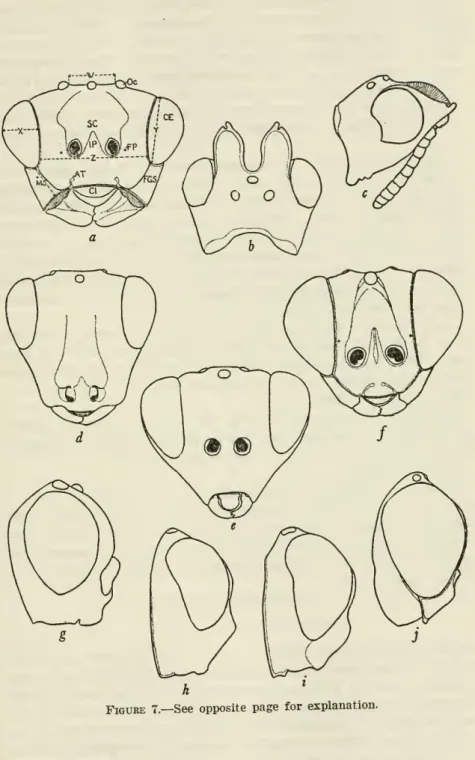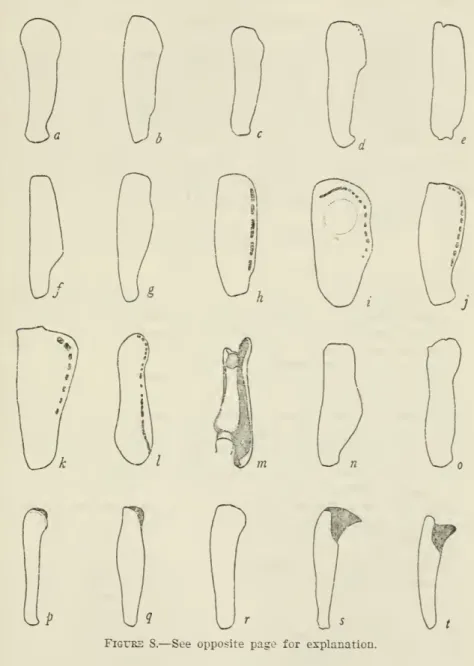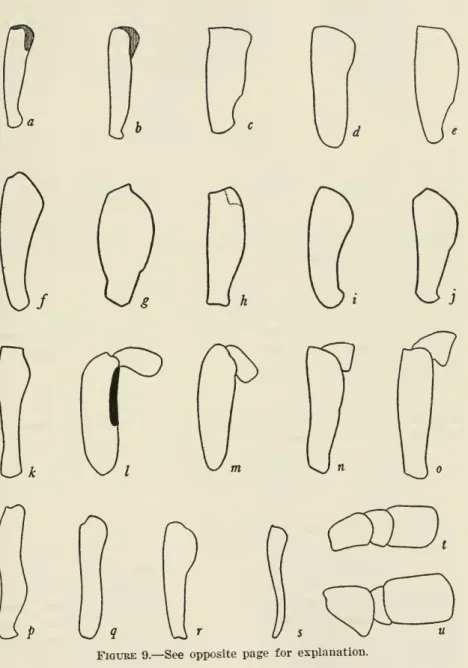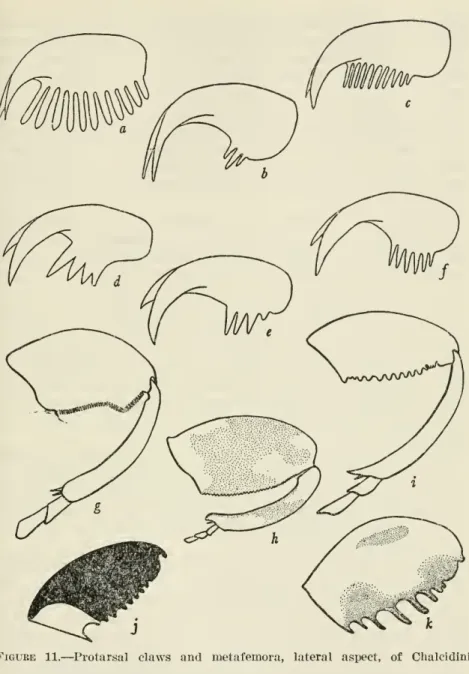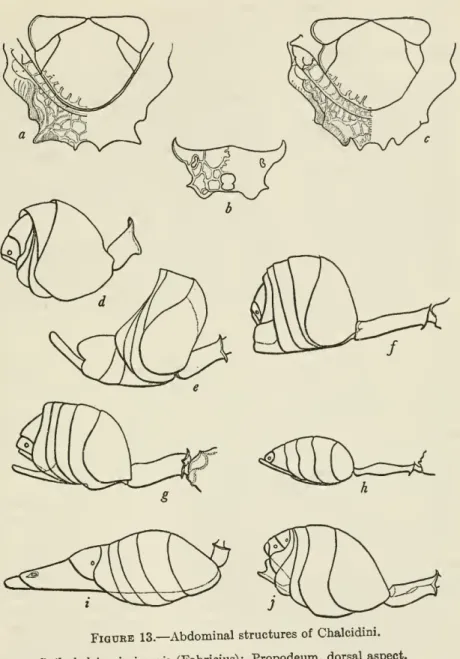Olaw Schroeder, of the Kiel Museum, made comparisons with the types of the two Fabrician species from. Prof.R.H.Painter, Kansas Agricultural College, Manhattan, Kans.; Dr. William Procter, Biological Survey of the Mount Desert Region, Bar Harbor, Maine;.
THE TRIBE CHALCIDINI — BURKS 247
Propodeum coarsely and irregularly carinate, large, lateral teeth projecting on each side of insertion point of petiole, spiracular openings vertical; petiole glabrous, twice as long as broad, a few small lateral, subbasal projections usually present; gaster usually equal to metafemur, abdominal segments 4 to 7 densely covered with lateral setae; eighth tergite densely setose; cerci round, located near posterior marginofepipygium; apex of ovipositor sheath provided with a pair of long, ventral setae; apex of hypopygium isolated. This species is closely related to Ch-alcis divisa (Walker), but is most easily distinguished by these characters: Body long, narrow, conspicuously covered with long white setae of various lengths, posterior carina of head extending from base of mandible to posterodorsal corner of head, apicallamina or mesoscutellum not depressed fop meson.
THE TRIBE CHALCIDINI — BURKS 249 male two small areas at posterolateral angles of mesopraescutum, wide
Antennae inserted slightly into the ventrad of the center of the frown, with a quarter of the length greater than the level of the posterior ocelli, annular segment less than half the length of the peduncle, segment 4 one-eighth longer than 5, segments 5 to 7 equal , the next shorter, except 13, which is equal to a length of 7; a series of parallel transverse ridges present in the cavity of the scrobe, just ventral to the anterior ocellus; a prominent transverse carina present on the anterior just ventrad of the antennal bases; malar space two-thirds height of compound eye;. Propodeum conspicuously carinating over the entire surface; spiral openings vertically; petiole glabrous, two-thirds length from metacoxa, a pair of small lateral processes present on each side near the base;
THE TRIBE CHALCIDINI — BURKS 251 segment with a few dorsal setae, following segments uniformly cov-
252 PE0CEEDI2sGS XATIOXAL MUSEUH vol.88 Pronotum with distinct laterodorsal tufts of pubescence; point on dorsum of thorax rough, irregular; parapsidal grooves partially obscured posteriorly; mesopraescutiun with mesal longitudinal depression; prepectus visible only as small triangular sclerite in anterolateral corner of mesoscutum: mesoscutelluni slightly emarginate at apex: mesotibial spur small; metacoxies slender, sparsely covered with long pubescence; the outer surface of the metafemur is densely covered with short pubescence, there are scattered longer setae on the base and on the ventral margin, there are 14 to 16 teeth on the outer ventral margin. Propodeum distinctly carinate, laterobasal areas with carinae directed obliquely from meson, two strong, lateral, subapical carinae present, spiral opening vertical; petiole twice as long as wide, surface conspicuously covered with irregular dorsal carinae and folds, two strong lateral carinae on either side, ventral one becoming obsolete before reaching apex, row of long, dense setae on each lateral margin; gaster usually equal in length to metafemur.
THE TRIBE CHALCIDIXI — BURKS 253
Leading (fig. 8, c); compound eyes prominent, projeotinir: malar space one-fourtli height of compound eye;. Antennal scape (fig. 8, e); forehand claw with several long, comb teeth on basal enlargement (fig. 11, d); meta- femur with distinct inner tooth; ninth sternite broadly excavated on meson (fig. 14, e).
THE TRIBE CHALCIDINI BURKS 257
Prepectus narrow, blade-like, slightly wider anteriorly, apex not quite reaching tegula; mesotibial spur minute; outer surface of meta-femur densely covered with short pubescence, outer margin of abdomen with nine to twelve minute teeth, basal slightly larger than spoke. Propodeum completely covered with small setae, these setae slightly stronger near apex, spiracular opening vertical, slightly narrowed in middle; tail short, less than twice as long as wide, surface provided with thick, tangled carinae, distinct lateral carinae present at base but usually obsolete before reaching apex; gaster usually slightly longer than metafemur; cerci oval, located near posterior margin of epipigium; the apex of the egg-shell, produced into a long, acute point, a rare set of incisions.
THE TRIBE CHALCIDINI — ^BUBKS 259
Prepectus narrow, leaf-like, top-reaching tegula; mesotibial spur large; ventral half of outer surface of metafemur provided with dense, short pubescence, outer ventral margin with 13 to 16 teeth (fig. 11, ^'), basal one and usually fifth to tenth larger than others;
THE TRIBE CHALCIDINI — BURKS 261
The tip of the antennal landscape just reaches the level of the posterior ocelli, the flagellar segments are stout; scrobe cavity deep, margins carinate on ventral half; frons punctate laterally, smooth or very weakly emarginate mesally ventrad of antennal bases, lateral carinae present parallel to anterior margins of compound eyes;. Dorsum of thorax thickly covered with large punctures, pubescence short, white or yellow; entire anterior dorsal margin of pronotum carinate.
THE TRIBE CHALCIDINI BURKS 263
All the reared species of this genus are parasites of the pupae of Lepidoptera, Coleoptera, Hymenoptera, or, rarely, cyclorrhaphous Diptera. Frontogenal suture lacking, clypeus only slightly wider than long (fig. 7, e); antennal sockets often on a line with ventrals.
THE TRIBE CHALCIDINI — BURKS 265
THE TRIBE CHALCIDINI — BURKS 267
Back of thorax thickly pitted, uniformly covered by long yellow setae; The anterolateral corners of the pronotum are strongly produced. Antennal outline (fig. 8, h) uniformly wide from base to apex; combined width of compound eyes equal to interocular space at level of antennal bases; inner tooth of metafemur absent; gaster usually slightly larger than metafemur.
THE TRIBE CHALCIDINI — BURKS 269
Propodeumsetose, strongly carinate, prominent lateral teeth present in posterolateral corner of propodeum, spiral apertures nearly vertical; petiole is short, strong, glabrous, with lateral carinae; basal lamina wide on ventral side; stomach slightly longer than metacox, abdominal segments 3 to 7 with lateral appendages; spiral apertures on eighth tergite large, anterior margins straight; osmotergiteglabro, without bristles; cercus small, almost round, located midway between the anterior and posterior margins of the phepipygium; sheath ovoidsetose atapex. The antenna is broad (Fig. 8, ^), the inner tooth of the meta-femur is absent; metatibia with apex usually slightly pointed.
THE TRIBE CHALCIDINI — BURKS 271
Description.— Markings yellow or red with black; mesopraescutum except lateral and posterior margins, mesal margins of mesoscutum lobes, mesal halves of axillae, anterior margins of mesoscutellum, tips of metacoxes, three small markings on outer side of most or all of meta-femorodeum, , and usually petiole, black;. Tip of antennal view not quite reaching level of ventral margin of anterior ocellus; pedicel two-fifths and ring fifth segment the length of segment 4, 5 slightly shorter than 4.
THE TRIBE CHALCIDINI — BURKS 273
Antennae short and stout, apex does not quite reach the level of the ventral margin of the anterior ocellus, pedicel half and ring segment one-sixth length of segment 4, segment 5 slightly shorter than 4, segments 5 to 11 equal, 12 and 13 narrower and shorter; scrobe cavity deep, marginal carina vague ventrad;.
THE TRIBE CHALCIDINI — BURKS 275
The male of this species differs from all other species in the genus occurring in this area in that the mesal flange of the antennal scape is produced ventral from the antennal base (fig. 8, m) and the frons is excavated to receive this projection . . Description.— Redor yellow with black markings; mesopraescutum with narrow T-shaped mark, mesal edges of lobes of mesoscutum, mesal angles of axils, mesoscutellum with narrow, longitudinal mark, apices of metacoxae, variable marks at outer ventral edges of metafemora, and tops of ovipositor sheaths.
THE TRIBE CHALCIDINI — BURKS 277
278 PROCEEDINGS OF THE NATIONAL MUSEUM Vol. 88 projections slightly inverted and transparent, a small carina usually present on the back of each; metepisternum coarsely reticulate, provided with a few very long setae on ventral half; metacoxae hemispherical, glabrous, furnished with scattered long setae except on outer dorsum; metafemora (Fig. 12, e) glabrous, sparsely covered with short pubescence, outer basal ventral tooth small, second tooth smaller than basal, two subsequent teeth, long, narrow, sharp, apical teeth divided to form two or three small unclear;. Antenna with median lamina produced ventrad of base of antenna (Fig. 8, I,m); width of malar space slightly less than one-third height of compound eye; combined widths.
THE TRIBE CHALCIDINI — BURKS 279
Cresson, Synopsis of the families and genera of the Hymenoptera of America north of Mexico, p.
THE TRIBE CHALCIDINI — BURKS 281 of anterior ocellus, pedicel one-half and ring segment one-sixth
Synonyms: hracata Sanborn, Boston Society of Natural History (comparisons made by Dr. Richard Dow); hracata coaequalis Cresson, 1788, Academy of Natural Sciences in Philadelphia; Carolina Ashmead, 41181,U. Richard Dow, of the Boston Society of Natural History, informs me that the type of C.
THE TRIBE CHALCIDINI — BURKS 283
JSmicra conjungens was described from a single female specimen from Mexico a year before the publication of the description of Smicra coxalis Cresson. A specimen which I had compared with the type of the latter species was sent to the National Museum of Natural History in Paris for comparison with Walker's type.
THE TRIBE CHALCIDINI BURKS 287 antennal bases ; left mandible with two teeth, ventral one larger, right
Antennal landscape narrowed just ventral of apex, reaching level of posterior ocelli, pedicel slightly less than half and ring segment one-sixth length of segment 4, segments 4 to 9 equal in length, 10 slightly shorter, 11 two-thirds length of 10, 12 and 13 combined slightly longer than 11; scrobe cavity deep, margin carinate only at ventral margin and ventralon-fourth of lateral margins, inter-antennal projection broad, without an apical lamina; frons without lateral carinae; frons deeply and densely punctate except on small spot just from dorsum to clypeus; frontal tentorial pits not visible; the width of the malar space slightly less than one-third the height of the compound eye;.
THE TRIBE CHALCIDINI — BURKS 289
Dorsum of thorax covered with large punctures, spaces between punctures minutely reticulate; pubescence long, fine; anterolateral angles of pronotum carinate; anterior dorsal margin of pronotum acarinate on mesal one fourth; parapsidal furrows distinct; surface of mesopraescutum slightly higher than surface of mesoscutum; prepectus narrow, tongue-like, not quite reaching tegula; anterior margin of mesoscutellum with a small projection mesally, pointed with a minute lamina; metepisternum covered with deep, nearly continuous pits; metacoxae relatively slender, surface almost smooth, reticulations extremely weak; metafemora smooth, outer surface densely covered with short pubescence, outer ventral margin with 11 to 18 small blunt teeth; inner tooth missing; basal enlargement of hind claw with several large teeth.
THE TRIBE CHALCIDINI BURKS 291 The femorata Group
Tip of antenna scape markedly above level of posterior ocelli; head, from dorsal aspect, much smaller than half as. Tip of antennal scape reaches level of dorsal margin of anterior ocellus, pedicel equal to and ring segment one quarter length of segment 4, segment 5 slightly shorter than 4, 6 slightly longer than 5, 6 to 10 equal, 11 slightly shorter, 12 slightly longer than 10, 13 as long as 11; scrobe hollow shallow, onlj^ ventral margin carinate; interantennal projection with a small anterior carina; frons minutely reticulate laterally of scrobe cavity, sparsely punctate just anterior to posterior ocelli and ventral of antennal bases; frontal tentorial pits not visible; width of malar space one third of height of compound eye; frontogenous suture slightly curved, almost straight; combined widths of compound eyes equal to interocular space at level of antennal bases; left mandible with two acute teeth, ventral one slightly larger; diameter of posterior ocellus slightly less than half an interocellar space; width of head one-fourth greater than maximum dorsal width of thorax.
THE TRIBE CHALCIDINI BURKS 295
Propodeum usually entirely without setae, surface provided with strong carinae, area between carinae glabrous, spiracular apertures oblique, a very slight projection representing a posterolateral angle of propodeum; petiole two and a quarter times as long, entire surface glabrous and subequal, basal lamina broad, lateral carina absent; gaster acuminate, slightly longer than metafemur, abdominal tergites 4 to 7 with long, sparse lateral walls; eighth tergite thin and obscurely reticulate, long, sparse; spiracular openings round; cerci oval, located between anterior and posterior edges of epipygium; apex of ovipositor sheaths with several short ventral setae. Antennal scheme (fig. 8, q) enlarged in the middle; flagellum stout, segments usually as wide as long; width of malar space two-fifths of height of compound eye; combined widths of.
THE TRIBE CHALCIDINI — BURKS 297
Antennae inserted ventrad from middle of frons. fig. 7, /), apex of scape exceeding level of posterior ocelli, pedicel five-eighths and change segment one-eighth length of segment4, segment. Antennal ramus (fig. 8, r) broad at apex; malar space one-fourth height of compound eye; combined widths of compound eyes slightly less than interocular width at level of antennal bases; inner tooth of metafemur sharp; petiole twice as long as wide, with lateral carinae indistinct or wanting.
THE TRIBE CHALCIDINI — BURKS 301
The variation in coloration of this species seems to correlate very well with the mean temperatures of the localities where it has been collected, as the specimens are either from high or northern elevations. Tip of antennal scape exceeding level of posterior ocelli by one-fourth of length, scape and ring segment usually equal in length, their combined lengths equal to segment 4, segments 4 to 7 usually equal, 7 sometimes slightly shorter, 8 and 9 always shorter than 7, 10 variable in length, usually slightly shorter than 9, last three segments indistinctly divided, their combined lengths usually equal to segment 4; scrobe cavity shallow, margin carinate at ventral margin and on ventral half of lateral margins, latter strongly curved mesad; interantennal projection with a slight anterior carina; frons with few scattered, indistinct punctures, oblique carinae radiating from ventral and lateral margins of anterior ocellus, usually three transverse carinae present in scrobe.
THE TRIBE CHALCIDINI — BURKS 305
THE TRIBE CHALCIDINI — ^BURKS 307
The vertebra is broadly rounded, so that the anterior ocellus is directed somewhat dorsad instead of in the usual anterior direction; the thorax is, in all but one species in this region, rather compact and broad (Fig. 10, c). Lateral ocelli nearly contiguous with compound eyes pallens (p. 319) Lateral ocelli separated from rim of compound eyes by a.
THE TRIBE CHALCIDINI — BURKS 309
Propodeum with strong mesal and apical carinae, meticulously sheared elsewhere, a small tooth present at each posterolateral corner, spiral openings vertical; petiole short, only one and a half times as long as wide, dorsal surface glabrous, basal lamina narrow, short lateral carinae present near the base; gaster a quarter to a third longer than metafemur, abdominal segments 5 to 7 each with a pair of lateral patches of setae, segments 4 to 7 each with a double row of setae on dorsal surface; eighth tergite, minutely reticulate, covered with quite long pubescence, round spiral openings; epi-. Antenna structure (Fig. 9, c) slightly shorter than in females; width of the malar space one-third height of the compound eye;
THE TRIBE CHALCIDINI — BURKS 311
312 PROCEEDINGS OF THE ]SrATIONAL MUSEUM vol.88 of dorsal area; anterolateral margins of pronotum strongly carinate. Propodeum provided with a pair of large carinae, two lateral areas at base minute-green, a small tooth present at each posterolateral angle, spiracular apertures nearly vertical.
THE TRIBE CHALCIDINI — BURKS 313
Propodeum covered by strong, rather irregular carinae, a small tooth present at posterolateral corner, spiracular apertures nearly vertical; petiole short, glabrous on dorsal side, finely reticulate. The female was described as Smicraencausta Cresson, from Colorado; type, 1789, Academy of Natural Sciences of Phila- delphia.
THE TRIBE CHALCIDINI — BURKS 315
Propodeum provided with strong mesal and apical carinae, two basolateral areas more weakly and irregularly carinate, areas between carinae finely deformed, spiracular openings slightly oblique laterally, propodeum with a small projection at each posterolateral corner; petiole slightly less than twice as long as wide, all exposed surfaces with slight greening and short carinae, basal lamina narrow, interrupted at dorsolateral angles, lateral carinae present;. Top of antennal sheath does not reach level of ventral margin of anterior ocellus, pedicel one and a half and rino-.
THE TRIBE CHALCIDINI — BURKS 317
This species is most easily recognized by the head, from the dorsal aspect, which is half as long as it is wide, with the cavity of the cavity deep, the metacoxa having a completely glabrous outer dorsal surface, the abdominal petiole short and the abdomen rather strongly compressed. Antenna structure (fig. 9, /) with apex not quite reaching the level of the ventral margin of the anterior ocellus, stalk slightly longer than segment 4, ring segment half the length of stalk, segment 5 slightly shorter than 4, segments 5 to 10 equal , 11 and 12 slightly shorter than 10, 13 equal to 10; cavity deep, edge serrated at ventral and dorsal margins, dorsal carina located just ventral to anterior ocellus; interantennal projection with a small dorsal carina; frown deep but scattered pierced laterad of scobe cavity, ventrad of antennal bases a few irregular transverse carinae present, area laterad of scrobe cavity slightly produced cephalad; frontal tentorial pits located just laterad of the antennal bases, slightly above the level of the ventral margin of the scrobe cavity; width of the jaw space one-third height of the compound eye; frontogenal suture curved; genital area behind the suture with rather indistinct oblique rows of large holes; combined width of compound eyes slightly less than the interocular width at the antenna bases; left.
THE TRIBE CHALCIDINI — BURKS 319
It differs from that species in that the scrobe cavity is shallow rather than deep, and the outer dorsal surface of the metacoxa is glabrous rather than shagreened. Antenna stalk short, apex does not quite reach the level of the ventral margin of the anterior ocellus, stalk equal in length to.
THE TRIBE CHALCIDINI — BURKS 321
Smicra odontotae (Howard) Cbesson, Synopsis of the families and genera of the Hymenoptera of America north of Mexico, p. This small, dull yellow species is most easily recognized by its short antennal shell and strong flagellum, with the annulus half as long as segment 4, the shallow cavity of the cavity, and the head dorsally half as long as wide, and a strong carina on the genal region of the head, which extends from the base of the mandible to the lateral ocellus.
THE TRIBE CHALCIDINI — BURKS 323
This species is most easily recognized by its compact body, with the antennal sheath short and flagellum obtuse, the head, from the dorsal aspect, half as long as wide, the metafemora semi-ovate and with 18 or more minute ventral teeth, the basal one rounded , not acute. fig. 12,^), and the abdomen strongly compressed. Apex of antennal shape not quite reaching level of ventral margin of anterior ocellus, pedicel slightly longer than segment 4, ring segment half length of pedicel, segments 4 to 11 equal in length, 12 and 13 slightly shorter; scrub cavity deep, margin indistinctly carinate at dorsal and ventral margins, several indistinct transverse carinae usually present in scrub cavity just ventral to anteriorocellus; interantennal projection with a minute dorsal carina; deep, narrowly set punctures on frons lateral to scrobe cavity, punctures scattered ventrad from antennal bases, tending to merge to.
THE TRIBE CHALCIDINI — BURKS 325
Dorsum of thorax entirely black, without any color spots; antennal scape (fig. 9,j) short and strong; frontal tendon pits located at level of ventral margin of scrob cavity, midway between antennal bases and anteriorgena of compound eyes; width of mela spaces slightly less than one-third of height of compound eye; gena caudad area of frontogenal suture provided with short, irregular carinae and small reticulations; combined width of compound eyes three-quarters of width of interocular space at level of compound eyes; diameter of posterior ocellus slightly less than one-third width of intercellular space; the tip of the mesoscutellum is provided with a narrow layer which is only very slightly depressed on the meson; apex of metatibia acute; no lateral projections present on propodeum; petiole half as wide, dorsal side glabrouson. These species are all small or diminutive, mostly black and equipped with small, irregularly colored spots.
THE TRIBE CHALCIDINI — BURKS 327 There is invariably a row of four or six small, round colored spots
Entire area of afrons later and ventrad of scrobe cavity yellow or whitish; diameter of lateral ocellus greater than the width of the area between the lateral ocellus and the inner margin of the compound. Antennae inserted dorsad of ventral margins of compound eyes; width of interantennal space equal to or greater than width of space between antennal fossa and compound eye.
THE TRIBE CHALCIDINI — BURKS 329
Dorsum of thorax finely green, provided with large pits except on two rounded anterolateral areas of mesopraescutum. Dorsal surface of propodeum strongly carinate except on two baso-lateral areas, latter covered by small confused reticulations, a small apical projection present on each side of insertion point of petiole, spiracular slits slightly curved laterally; petiole short, only slightly longer than wide; finely greenish and with distinct lateral carinae, basal lamina narrow; gaster usually equal in length.
THE TRIBE CHALCIDINI — BURKS 331
This species is most easily recognized in the female by the longitudinal dorsal length of the epipygium being one and a half times the length of the eighth tergite; the male has an extremely stout antennal scape, which is inserted at the level of the ventral margins of the compound eyes, and the apex exceeds the level of the posterior ocelli. 4, last three slightly shorter; scrobe cavity shallow, rim completely without carinae, or with a very indistinct ventral, a smooth area just later smell of each antennal base; interantennal projection broad, usually with a small dorsal carina; frons covered with small reticulations over entire surface, reticulations forming vague, small parallel carinae on area laterally of scrobe cavity; width of malar space three-quarters or more height of compound eye; combined widths of compound eyes one-fifth less than width of interocular space at level of apex of interantennal projection; left man-.
THE TRIBE CHALCIDINI — BURKS 333
334: PBOCEEDrS"GS OF THE XATIOXAL MUSEUM vou88 . Posterior thorax closely and iri-regularly pitted, pubescence scattered, fine, slightly longer and thicker on posterior margins of mesopraescutum and axilla , and between the sterile and the lower sideX) : anterolateral and sublateral angles of the pronotum produced, wrinkled. anteriordorsal margin acarinate : parapsidal furrows well defined : prepectus narrow, tip trumpeted, spreading totegula ; tip of mesoscutum with a mesallv lamina sunken, narrow, lamination narrow, on the upper part of the metepex and strong. , two large lateral areas, with small webs at the base, a pair of small projections on the lateroentral corners of the propodeum, spiracular openings slightly inclined laterally; petiole twice as long, entire surface shaded, basal lamina narrow, in lateral view, appearing to be at right angles, leg injections. lateral carina present.
THE TRIBE CHALCIDIXI BURKS 335
Propodeum shagreened, strongly carinated only laterad, a small tooth present on each posterolateral corner, spiracles curved laterad;. Gbesson, Synopsis of the families and genera of the Hymenoptera of America north of Mexico, p.
THE TRIBE CHALCIDINI BURKS 337
338 PROCEEDINGS OF THE NATIONAL MUSEUM 70U 88
THE TRIBE CHALCIDINI — BURKS 339
The two specimens now in the collection of the Academy of Natural Sciences of Philadelphia, labeled "Smifrt^aalbifrons," disagree with his redescription of the species. This species was undoubtedly bred from some primary ichneumonoid parasites of the following moths: Plathypena scohra (Fabricius) and Thyridopteryx ephemeraeformis Haworth.
THE TRIBE CHALCIDINI — BURKS 341
In the male of this species the antennae are always inserted at the level of the ventral margins of the compound eyes; the stem is. In the female, the apex is subacute, the interocular space wide and the eyes narrow, and the mesal projection of the eighth sternite is acute; this latter character is often difficult to see, as the tergites of the anterior abdominal segments usually project ventradally to conceal the eighth sternite.
THE TRIBE CHALCIDINI — BURKS 343
Description.— The antennal leaf is long, either reaching the height of the posterior eyes or distinctly exceeding it; left mandible with two or three teeth, right mandible always with three teeth; body shallow and irregularly punctate, dorso-thorax often partially bare;. pubescence conspicuously long, white; metafemora relatively slender. fig. 12, Z-6>), outer ventral margin with numerous, small teeth, the basal ones always slightly longer than the following ones; peduncle long, slender, varying from 8 times as long as broad to 15 times as long as broad, length of peduncle always equal to three-quarters or more length of metacox, often as long as metacox; petiole only occasionally enlarged. A strong tooth projects from the venter of the propodeum between the bases of the metacoxa; petiole 14 or more times as long as broad.
THE TRIBE CHALCIDINI — BURKS 345
Antennal sheath (fig. 9, p) exceeding level of posterior ocelli; metafemur with inner tooth blmit; petiole slightly longer than metacoxa, and only slightly enlarged at apex; gaster equal to or shorter than metafemur.
THE TRIBE CHALCIDINI — BURKS 347
52 reproduced by the International Commission argues that the designation of atype locality does not validate a name, and the host designated in the above quote is likely to be attacked by other members of this genus. In the same year that this manuscript name was published, Howard treated this species under the name.
THE TRIBE CHALCIDINI BURKS 349
National Museum, a paratype in the Illinois State Natural History Survey collection, and a paratype in the University ofKansas collection. The tip of the antennal scape exceeds the level of the posterior ocelli; ring segment one-third length of segment 4, all flagellar segments about equal in size, stout, covered with white pubescence; scrobe cavity shallow, margined only at ventral one-eighth; frons laterad of scrobe cavity strongly punctured, minutely shagreened ventrad of antennal bases; malar space one-fourth height of compound eyes; combined widths of the connection slightly greater than the width of the interocular space at the level of the antennal bases; left man-. dibble with two acute teeth, right mandible with three; frontogenic suture faint or completely obscured; diameter of f)Oterior ocellus half width of interocellar space.
THE TRIBE CHALCIDIXI — BURKS 351
EXCLUDED SPECIES
UNPLACED SPECIES
Species of the genus Chalcis are larval parasites; all other species in this tribe that have been reared are pupa parasites.
THE TRIBE CHALCIDINI — BURKS
HYMENOPTERA
